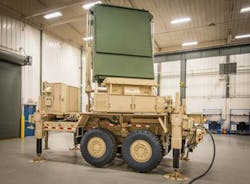Due to an increasing number of active missile threats, constant improvements are needed in radar technologies, and Lockheed Martin has revealed its intentions to unveil its next-generation air and missile defense radar demonstration system at the annual Space & Missile Defense Symposium (Huntsville, Ala.). Using active electronically scanned array (AESA) technology, the AESA Radar for Engagement and Surveillance (ARES) system is a prototype of a system that will be capable of 360-deg. scanning for the U.S. Army to defend against present and future ballistic missile threats.
The ARES system employs a fractional antenna array for full detection and identification of potential threats. It is a modular and scalable design that can be adapted as a modern replacement for the Army’s older radar systems, such as the Patriot MPQ-65 radar. As Mark Mekker, director of Next Generation Radar Systems at Lockheed Martin, explained, at times a totally new system approach may be needed rather than trying to continuously upgrade an older defense electronics system.
“Incremental upgrades to the existing Patriot radar no longer address current sustainment issues, current threat performance shortcomings, or provide growth for future and evolving threats,” said Mekker. “Lockheed Martin is prepared to offer a next generation missile defense system that will leverage advances in radar technology to provide a modular, scalable architecture and reduce the total cost of ownership well over its 30-year lifecycle.”
The AESA technology incorporates solid-state GaN amplification for high power density and high efficiency, combined with proven 360-deg. sensor/fire control algorithms based on advanced threat scenarios. The AESA technology is also in use in the AN/TP/Q-53 radar system, which Lockheed Martin designed, developed, and delivered to the Army on an urgent need timeline in under 36 months, and which continues to be scaled to address emerging threats.
“Our solution for the U.S. Army’s new air and missile defense sensor is not a new-start program,” Mekker noted. “It’s a combination of technology maturation over several years, and includes capability leveraged from our current development programs and battlefield-proven radars. We rely heavily on our modern radar systems such as the Q-53 and the Long Range Discrimination Radar to rapidly bring low-risk, proven technology to the warfighter.”


